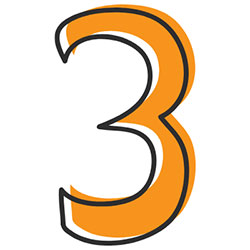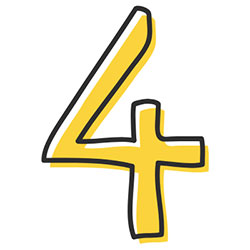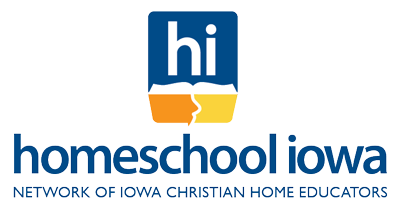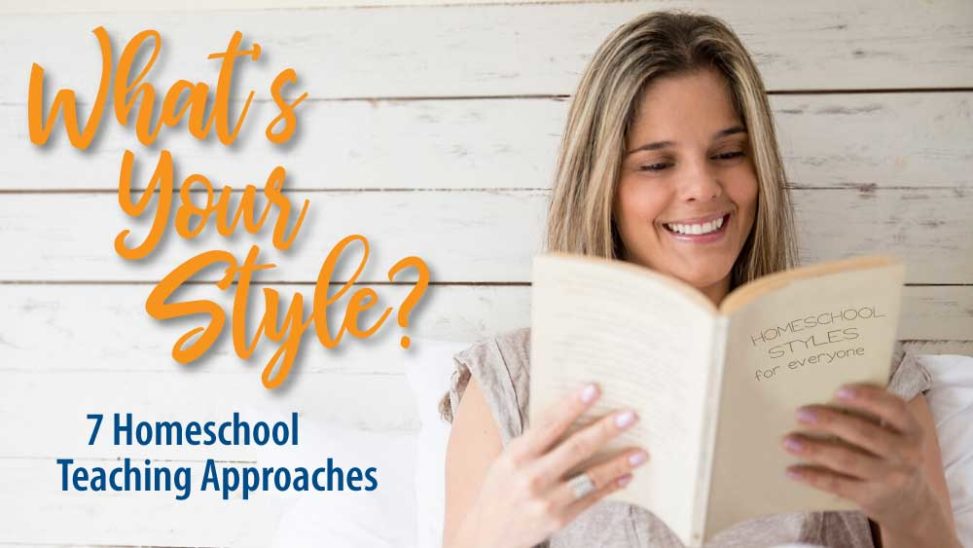Exploring the different homeschooling approaches is a good place to begin if you’re just starting your homeschool adventure.
Even if you’ve already opted for one particular style, learning a bit about the other approaches can help you develop and expand your methods as you continue your homeschool journey.
Here is a listing, with links to sample resources, of seven of the most common homeschool teaching approaches:
- Traditional
- Online or Correspondence Instruction
- Classical
- Charlotte Mason
- Unschooling
- Unit Studies & All-in-One Programs
- Eclectic

TRADITIONAL
If you attended any kind of public or private school, this is probably the style you experienced.
It uses graded textbooks or workbooks that systematically cover each subject, usually in a period of 180 days per year, over a span of 12 years. Teacher's manuals, tests, and record-keeping materials are typically offered with each of the subject texts.
The traditional textbook approach assumes you will conduct your homeschool much like an institutional school.
Explore More:
Some publishers offer complete lines of textbooks, covering all subjects K-12. These include Abeka, BJU Press, Rod & Staff, and AOP’s LIFEPAC, Christian Light Education, and Accelerated Christian Education (ACE).
There are also many individual subject curriculum publishers. (Learn more in the Homeschool Iowa Resource Guide on our website Member Portal.)
CHALLENGES:
• Approaches teaching as a filling of student minds with information
• Assumes that most children learn the same way and at the same pace
• Can be expensive
STRENGTHS:
• Follows a standardized progression
• Provides clear instructional steps
• Uses familiar methods most people have experienced

Online or Correspondence Instruction
A close cousin of the traditional style, online and correspondence school instruction delivers the same systematic instruction of basic subjects (usually in semester-based periods) but in a digital format.
This style is often popular with parents who are just starting to homeschool, but lack confidence in their teaching abilities – especially at the high school level. It can also be used as a supplement for single subjects (like calculus or physics) or for a fallback plan for challenging seasons (like times of illness or when a new baby is added to the family).
Online programs use digitally-delivered programmed lessons. Some programs and correspondence schools even provide live instruction by certified teachers.
Many offer placement tests to assist in determining grade level. They also provide automated grades and final reports at the end of the year.
Explore More:
Some popular online programs include AOP’s Switched on Schoolhouse & Monarch, BJU Distance Learning Online, CLASS Homeschools, and Teaching Textbooks (math).
Commonly used correspondence schools include Abeka Academy and Alpha Omega Academy.
CHALLENGES:
• Uses a somewhat rigid learning platform
• Depends heavily on screen-delivered instruction
• Usually requires a reliable internet connection and can be expensive
STRENGTHS:
• Offers preplanned lesson content and automated record-keeping
• Supplies instructional support for challenging subjects
• Provides, in some cases, transcripts and even diplomas

CLASSICAL
This homeschool style focuses on passing down the elements of Christian culture while building character and virtue. It uses time-honored methods to develop children’s thinking skills to help them differentiate good from evil and truth from falsehoods by exposing them to the best writers, artists, and thinkers throughout history.
The Classical method teaches children core knowledge and skills based upon their natural development. The three stages of learning in a Classical education, collectively known as The Trivium, are:
- Grammar: The early elementary years are focused on developing basic language arts and math skills while encouraging observation, listening, and memorization abilities. The Grammar stage acknowledges that young children’s minds are like sponges, absorbing facts and details about the world around them.
- Logic/Dialectic: As children enter upper elementary years, they begin to demonstrate independent or abstract thought (often illustrated in their desire to argue and express strong opinions). Classical education builds upon this natural tendency, teaching children how to analyze opinions, interpret events, detect fallacies, draw correct conclusions, and support arguments with facts.
- Rhetoric: The high school years are directed toward refining students’ grammar and logic skills and advancing their abilities to express ideas (both written and spoken) eloquently and persuasively.
Explore More:
Resources and tools, including the book Teaching the Trivium, are available on Harvey and Laurie Bluedorn’s website, Trivium Pursuit. Also explore The Well-Trained Mind by Susan Wise Bauer and Classical Conversations.
CHALLENGES:
• Calls for rigorous academic study
• Includes the study of Latin, Greek, and Hebrew
• Requires scholarly teachers or outside support
STRENGTHS:
• Develops learning based upon stages of mental development
• Advances thinking skills and verbal/written expression
• Cultivates self-learners


Charlotte Mason
This homeschooling style gains its name from Charlotte Mason, a British educator in the late 1800s and early 1900s who championed many educational innovations. She saw children as thinking, feeling human beings, with spirits to be kindled – not as vessels to be filled with facts and information.
The Charlotte Mason approach seeks to “spread a feast” before children, allowing them to “taste” and “digest” it naturally. The basic tenets are:
• Good habits that lead to good character
• Great books, called “living books,” that make subjects come alive
• Guided discovery that includes the study of nature, music, and art
Unlike many other homeschool styles, there are no textbooks, tests, or quizzes with the Charlotte Mason approach. Instead, innovative learning tools like copywork and narration are used.
Explore More:
Karen Andreola’s book, A Charlotte Mason Companion, is one of the most trusted and referred-to books on this method. Another book to check out is Susan Schaeffer Macaulay’s For the Children’s Sake. Miss Mason’s original writings and many additional resources are available on the Simply Charlotte Mason website.
CHALLENGES:
• Calls for active pursuit of quality materials & experiences
• Requires dedicated follow-through on habit development
• Tends to need supplementation at higher grade levels
STRENGTHS:
• Includes children as active participants in the learning process
• Stresses formation of good character and habits
• Encourages curiosity, creativity, and a love of learning

Unschooling
The Unschooling approach has its roots in the writings of John Holt, a 20th century American educator who concluded that children have an innate curiosity and desire to learn, which he believed was destroyed by traditional teaching methods.
Unschooling doesn’t imply the absence of discipline, and it does not mean that parents aren’t involved in their children’s educations.
Instead, Unschooling is a less structured learning approach that allows children to pursue their own interests with parental support and guidance.
Children are surrounded by a rich environment of books, learning resources, and adults who model a lifestyle of learning and are willing to interact with them. Formal academics are pursued when the need arises.
Explore More:
John Holt’s books, including How Children Learn, are available on the Growing without Schooling website. You might also visit the Christian Unschooling website.
CHALLENGES:
• Departs from traditionally-defined educational plans
• Relies upon the child’s desire for learning and discipline to pursue it
• Tends to meander and can possibly neglect some subject areas
STRENGTHS:
• Follows children’s interests and avoids burnout
• Promotes the development of self-learners with a love of learning
• Provides a discipleship model of learning

Unit Studies & All-In-One Programs
In traditional schools, children move from subject to subject, class to class, with each topic presented separately.
In a Unit Studies approach, a particular theme or topic is selected, and all subject-area study is focused upon it. Language arts, science, social studies, fine arts, and even math lessons are related to the theme.
For example, a Unit Study on birds could include reading and writing about birds and famous ornithologists, exploring the physiology and life cycles of birds, studying the aerodynamics of flight, investigating migration and ecological impacts of birds, maintaining a bird watching journal, building a bird feeder, and so forth.
Sometimes geographic locations or historical periods provide the inspiration for Unit Studies. In fact, almost any topic can form the theme for a Unit Study.
And while considering Unit Studies, we’ll also mention that there are a number of programs available that look like unit studies yet lack unifying themes. These All-In-One Programs provide schedules and lists of projects, readings, and assignments for each subject area or grade level. Some of these programs even offer complete packages with the listed resources provided.
Explore More:
Valerie Bendt’s book, Unit Studies Made Easy, is one of the top books for parents who want to create their own Unit Studies. There is a HUGE number of Unit Study resources and All-In-One Program sources, like My Father’s World, Sonlight, Heart of Dakota, Five-in-a-Row, Tapestry of Grace, Easy-Peasy, BookShark, Trisms, Timberdoodle, and more. Check out this link to Cathy Duffy’s reviews of some of these offerings: Unit Studies & All-In-One Programs.
CHALLENGES
• Requires advance preparations if designed by parent
• Leads to burnout if carried out to the extreme
• Uses non-traditional means for evaluation and record-keeping
STRENGTHS:
• Allows multi-aged children to learn together
• Offers learning based on curiosity and interest
• Provides in-depth study opportunities

Eclectic
Lastly, and quite naturally, we come to the Eclectic style.
As the definition of the word “eclectic” implies, this approach combines or incorporates portions of the different homeschooling styles listed above, resulting in a new, unique, and personalized method.
This method can be especially helpful in special circumstances. Perhaps you have multiple children, each of whom receive instruction differently. Or maybe you prefer using one style as your main teaching method, but opt for another method for one particular subject.
The Eclectic style is like using a “Homeschool Teaching Style Buffet!” You select what appeals to you from each offered style and leave the rest.
Explore More:
Read Kim Sorgius’ blog, “Eclectic Homeschool: When One Homeschool Method Isn’t Working” and Amy Milcic’s blog, “Eclectic Homeschooling: Use What Works for Your Family!”
CHALLENGES:
• Requires familiarity and application of multiple teaching approaches
• Can be overwhelming if many styles are used with multiple students
• Calls for creativity and versatility
STRENGTHS:
• Draws only applicable portions from the various homeschooling styles
• Provides adaptability for specialized circumstances
• Offers flexibility and customization

Now that you’ve explored these common homeschool styles, you’re ready to choose the one that will work best for your family.
There is no “right answer” for everyone.
There is no generalized “perfect” teaching style.
Consider your personal preferences, your children’s learning styles, and your family dynamics.
Make your choice and start your journey.
It’s likely that you’ll make adjustments along the way, and that’s okay!
If you’d like to chat with a seasoned homeschool mom about this subject, we encourage you to reach out to the Homeschool Iowa Regional Representative who serves your area.
If you’re on Facebook, join our Homeschool Iowa Discussion Group and bring up this topic to learn from other homeschoolers.
Share your thoughts and suggestions in the Comments section below. We’d love to hear from you!
© Homeschool Iowa



2 Comments on “What’s Your Style?”
I have “graduated” from homeschooling my children. They have now asked for advice in teaching their own children. You have clear, ample information and resources here that I can pass on. Good job and thank you!
Congratulations on completing your homeschooling journey, Mary! We’re happy to hear that you found our website helpful! Blessings to your children as they start their homeschooling adventures!